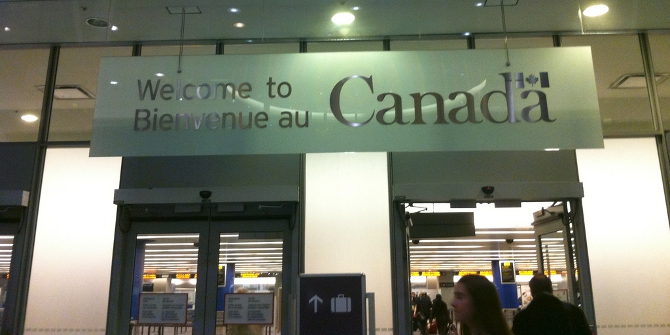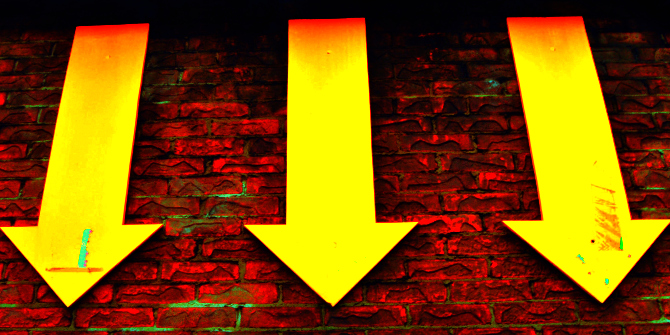

 To what extent does ideology influence what happens across states and the country as a whole? In new research, Juan Prieto-Rodríguez, Rafael Salas, and Douglas Noonan use air pollution levels as a measure of the effect of COVID-19 related restrictions on economic activity. They find that in the first few months of 2020’s COVID-19 lockdowns, there was a 53 percent fall average levels of nitrogen dioxide pollution, but that larger falls occurred in Democratic states compared to those with greater support for the Republican Party. Political ideology, they write, is often not as independent as it should be from the science of public health, with US state Democratic administrations more able to take protective measures during the pandemic.
To what extent does ideology influence what happens across states and the country as a whole? In new research, Juan Prieto-Rodríguez, Rafael Salas, and Douglas Noonan use air pollution levels as a measure of the effect of COVID-19 related restrictions on economic activity. They find that in the first few months of 2020’s COVID-19 lockdowns, there was a 53 percent fall average levels of nitrogen dioxide pollution, but that larger falls occurred in Democratic states compared to those with greater support for the Republican Party. Political ideology, they write, is often not as independent as it should be from the science of public health, with US state Democratic administrations more able to take protective measures during the pandemic.
While in early 2020 Donald Trump was very skeptical of the scientific evidence on the threat posed by COVID-19 and refused to take severe measures that might affect the economy and businesses, other policymaking authorities had a different approach. This left lower levels of government and their executive orders as the primary engines for policy response. For instance, on 23 March 2020, there were already eight states in lockdown: California, Illinois, New York, Connecticut, Louisiana, Ohio, Oregon, and Washington. Out of these states, only Ohio’s governor was Republican. However, many citizens prioritized championing their individual rights and freedoms by demonstrating throughout the country at the end of April 2020. Tensions rose over lost economic opportunities and freedoms due to lockdowns, risky behaviors and inadequate public health protections, and disputes over optimal policy responses.
Using air pollution to measure the effect of lockdowns
The COVID-19 outbreak gives us an opportunity to examine the relationships between political partisanship in the US and, on the one hand, advocates of more severe public health measures and, on the other, defenders of individual rights and freedom. In our analysis, we were particularly concerned with the effects of political ideology in state governments on Nitrogen Dioxide air pollution (NO2) levels as it is a good proxy for local economic activity and vehicle traffic. We analyze whether the political ideology of each state governor and their voters influenced the drops in NO2 levels seen after the COVID-19 outbreak.
NO2 drops were likely due to declines in mobility and economic activity caused by legal requirements associated to lockdown policies and, also, to precautionary measures taken voluntarily by the public before or even after lockdowns enforcement. Thus, ideology has a dual channel to influence mobility, activity and, ultimately, pollution. First, ideology has a direct pathway through people’s behavior. A Trump supporter may resist behavioral change and protest what they see as being an exaggerated crisis, while a Democratic voter may demonstrate great caution and diligently stay home.
Second, it also has an indirect pathway by influencing government policies and, through them affect behavior and thus mobility/activity. For instance, executive orders and stay-at-home mandates limited economic activity. These two pathways for ideology to affect mobility/activity and pollution allow us to identify whether policy was driving the results, or it was just the ideology that directly affects activity and pollution, or a combination of the two.

Photo by Martin Sanchez on Unsplash
To assess this dual path, we measured ideology by using three alternative variables: governor’s party affiliation, and Trump’s share of the votes in 2016 presidential election at county and state level. Since the appearance of COVID-19 can be considered an unexpected event, it is assumed that the distribution by political parties of the different governors and the Trump’s share of the votes in the 2016 presidential election are independent of the emergence of the disease (controlling for other public health drivers). Based on this assumption, we use data from the US Environmental Protection Agency (EPA) to check whether the observed drops in the levels of NO2 after the outbreak of the pandemic, measured at different air-quality monitoring stations distributed through the continental United States, had any relationship with the political affiliation of the state governor or the state population’s ideology. Political affiliations that were determined prior to the COVID-19 outbreak, of course, could not be the result of the pandemic. But could they explain the variety of local experiences with the pandemic, including different air quality improvements?
Democratic-led states had greater reductions in pollution
Figure 1 below shows moving averages of NO2 levels by governor’s political party. This is a first approximation to understand the effect of political parties in the US on the levels of air pollution after the outbreak of the COVID-19 pandemic.
Figure 1 – Evolution of NO2 levels in Republican and Democratic states

NO2 is present in cities and industrial areas due mainly to combustion processes associated with cars and industry. This explains the state differences in average levels, as their percentages of urban population, industry and chemical sectors differ. In general, Democratic states with more urban and industrialized economies have higher concentrations of NO2.
Between 29 February (the first announced COVID-19 death) and 16 April 2020 (when President Trump proclaimed a transfer of responsibility of how to restart shuttered activity to state governors), there was a 53 percent reduction in the cross-station average NO2 levels. However, there were larger cuts in Democratic states.
The importance of ideology for public health
Using models comparing the evolution of NO2 levels from the beginning of 2018 to the end of June 2020, which coincides with the minimum point of the new national deaths at the end of the first COVID-19 wave, we estimate that Republican states had significantly smaller cuts in the NO2 levels. This holds regardless of how the COVID-19 starting point is defined or how we measure the ideology effect.
Moreover, Trump’s share of votes by state performs statistically best among ideology measures in explaining pollution changes. The importance of state-level ideology in explaining local pollution levels points to the influence of policy beyond ideology directly affecting activity. Therefore, voters’ ideology may have an impact on NO2 that is a mix of the indirect and direct ideology effects. Given our results, Democratic governors with high voter support (i.e., states with a low percentage of Trump’s voters) could take additional measures during the outbreak of the pandemic, allowing ideology to indirect affect residents’ behavior. This is consistent with the prominent role played by some governors at the outbreak of the pandemic.
Figure 2 shows the average pollution reduction after the onset of the pandemic across the US. The bigger pollution declines tend to appear in Democratic leaning “blue states.” Figure 2 also shows how states’ air quality gains change as we go further into the pandemic.
Figure 2 – Average NO2 reduction by states

Finally, the difference between the Democratic and Republican states in their NO2 reductions narrowed after April 16. Therefore, Democratic and Republican states importantly differed not just in the initial scope of their mobility and activity restrictions but also in the speed at which they undertook them.
Our results are a clear example of how ideology is often not as independent as it should be from scientific issues regarding public health matters. This should make us think about the best strategy to follow in the future. Clear protocols for leadership by specialized health personnel should be established at any administrative level in all countries for future pandemics. This course of action would isolate us from purely ideological issues that may not be efficient or equitable and could also help public health authorities not to get distracted and focus on what their priorities should be.
- This article is based on the paper, ‘Ideology and policy decision-making in the face of the Coronavirus pandemic in the US’, in the Cambridge Journal of Regions, Economy and Society.
- Please read our comments policy before commenting.
- Note: This article gives the views of the author, and not the position of USAPP – American Politics and Policy, nor the London School of Economics.
- Shortened URL for this post: http://bit.ly/3A9XjUs






